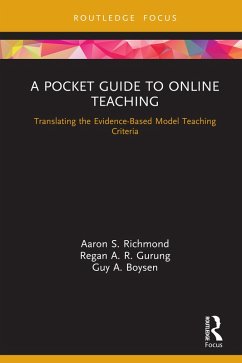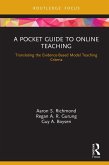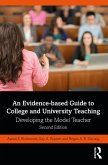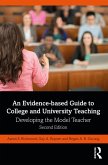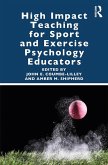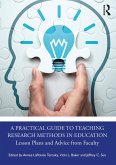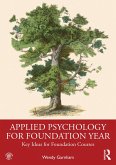Aaron S. Richmond, Regan A. R. Gurung, Guy Boysen
A Pocket Guide to Online Teaching (eBook, PDF)
Translating the Evidence-Based Model Teaching Criteria
21,95 €
21,95 €
inkl. MwSt.
Sofort per Download lieferbar

11 °P sammeln
21,95 €
Als Download kaufen

21,95 €
inkl. MwSt.
Sofort per Download lieferbar

11 °P sammeln
Jetzt verschenken
Alle Infos zum eBook verschenken
21,95 €
inkl. MwSt.
Sofort per Download lieferbar
Alle Infos zum eBook verschenken

11 °P sammeln
Aaron S. Richmond, Regan A. R. Gurung, Guy Boysen
A Pocket Guide to Online Teaching (eBook, PDF)
Translating the Evidence-Based Model Teaching Criteria
- Format: PDF
- Merkliste
- Auf die Merkliste
- Bewerten Bewerten
- Teilen
- Produkt teilen
- Produkterinnerung
- Produkterinnerung

Bitte loggen Sie sich zunächst in Ihr Kundenkonto ein oder registrieren Sie sich bei
bücher.de, um das eBook-Abo tolino select nutzen zu können.
Hier können Sie sich einloggen
Hier können Sie sich einloggen
Sie sind bereits eingeloggt. Klicken Sie auf 2. tolino select Abo, um fortzufahren.

Bitte loggen Sie sich zunächst in Ihr Kundenkonto ein oder registrieren Sie sich bei bücher.de, um das eBook-Abo tolino select nutzen zu können.
This pithy yet thorough book provides an evidence-based guide on how to prepare for online teaching, especially for those who are making a swift transition from face-to-face to online instruction.
- Geräte: PC
- ohne Kopierschutz
- eBook Hilfe
- Größe: 1.2MB
Andere Kunden interessierten sich auch für
![A Pocket Guide to Online Teaching (eBook, ePUB) A Pocket Guide to Online Teaching (eBook, ePUB)]() Aaron S. RichmondA Pocket Guide to Online Teaching (eBook, ePUB)21,95 €
Aaron S. RichmondA Pocket Guide to Online Teaching (eBook, ePUB)21,95 €![An Evidence-based Guide to College and University Teaching (eBook, PDF) An Evidence-based Guide to College and University Teaching (eBook, PDF)]() Aaron S. RichmondAn Evidence-based Guide to College and University Teaching (eBook, PDF)48,95 €
Aaron S. RichmondAn Evidence-based Guide to College and University Teaching (eBook, PDF)48,95 €![An Evidence-based Guide to College and University Teaching (eBook, ePUB) An Evidence-based Guide to College and University Teaching (eBook, ePUB)]() Aaron S. RichmondAn Evidence-based Guide to College and University Teaching (eBook, ePUB)48,95 €
Aaron S. RichmondAn Evidence-based Guide to College and University Teaching (eBook, ePUB)48,95 €![High Impact Teaching for Sport and Exercise Psychology Educators (eBook, PDF) High Impact Teaching for Sport and Exercise Psychology Educators (eBook, PDF)]() High Impact Teaching for Sport and Exercise Psychology Educators (eBook, PDF)40,95 €
High Impact Teaching for Sport and Exercise Psychology Educators (eBook, PDF)40,95 €![A Practical Guide to Teaching Research Methods in Education (eBook, PDF) A Practical Guide to Teaching Research Methods in Education (eBook, PDF)]() A Practical Guide to Teaching Research Methods in Education (eBook, PDF)46,95 €
A Practical Guide to Teaching Research Methods in Education (eBook, PDF)46,95 €![Applied Psychology for Foundation Year (eBook, PDF) Applied Psychology for Foundation Year (eBook, PDF)]() Wendy GarnhamApplied Psychology for Foundation Year (eBook, PDF)42,95 €
Wendy GarnhamApplied Psychology for Foundation Year (eBook, PDF)42,95 €![School Bullying (eBook, PDF) School Bullying (eBook, PDF)]() Phillip SleeSchool Bullying (eBook, PDF)39,95 €
Phillip SleeSchool Bullying (eBook, PDF)39,95 €-
-
-
This pithy yet thorough book provides an evidence-based guide on how to prepare for online teaching, especially for those who are making a swift transition from face-to-face to online instruction.
Dieser Download kann aus rechtlichen Gründen nur mit Rechnungsadresse in A, B, BG, CY, CZ, D, DK, EW, E, FIN, F, GR, HR, H, IRL, I, LT, L, LR, M, NL, PL, P, R, S, SLO, SK ausgeliefert werden.
Produktdetails
- Produktdetails
- Verlag: Taylor & Francis eBooks
- Seitenzahl: 84
- Erscheinungstermin: 8. März 2021
- Englisch
- ISBN-13: 9781000369823
- Artikelnr.: 60934426
- Verlag: Taylor & Francis eBooks
- Seitenzahl: 84
- Erscheinungstermin: 8. März 2021
- Englisch
- ISBN-13: 9781000369823
- Artikelnr.: 60934426
- Herstellerkennzeichnung Die Herstellerinformationen sind derzeit nicht verfügbar.
Aaron S. Richmond is a Professor of Educational Psychology at Metropolitan State University of Denver, USA. He studies how humans learn and develop and the application of this knowledge to classroom instruction and assessment.
Regan A. R. Gurung is Professor of Psychological Science and Director of the General Psychology Program at Oregon State University, USA. His research focuses on reducing prejudice, racism, and sexism, and the factors influencing learning.
Guy A. Boysen is a Professor of Psychology at McKendree University, USA. His scholarship emphasizes the teaching of psychology, professional development of teachers, and stigma toward mental illness.
Regan A. R. Gurung is Professor of Psychological Science and Director of the General Psychology Program at Oregon State University, USA. His research focuses on reducing prejudice, racism, and sexism, and the factors influencing learning.
Guy A. Boysen is a Professor of Psychology at McKendree University, USA. His scholarship emphasizes the teaching of psychology, professional development of teachers, and stigma toward mental illness.
Dedication
Preface
1. Apples and Oranges, But Still Fruit: Model Teaching Universals and Differences
1.1. Confessions of Three Skeptical Teachers
1.2. Stop, Think, Reflect: The Model Online Teaching Checklist for Training
1.3. Tips For Continued Learning About Model Online Teaching
2. Students Interaction with Content
2.1. Adapting Student Interaction with Content in Online CourseInteraction with Content Through Student Learning Objectives
2.2. Stop, Think, Reflect: The Model Online Teaching Checklist for Student Interaction with Content
2.3. Tips For Continued Learning About Students Interacting with Content
3. Student to Student Interaction
3.1. Adapting Student-to-Student Interaction: How to Build a Community of Online Learners
3.2. Stop, Think, Reflect: The Model Online Teaching Checklist for Student-to-Student Contact
3.3. Tips For Continued Learning About Student-to-Student Interactions
4. Instructor-to-Student Interaction
4.1. Adapting to Online Instruction to Promote Instructor to Student Interaction
4.2. Stop, Think, Reflect: The Model Online Teaching Checklist for Instructor-to-Student Interaction
4.3. Tips For Continued Learning About Online Instructor-to-Student Interaction
5. Online Assessment
5.1. How to Adapt Assessment to Online Instruction
a. The Process of Assessing Student Learning Online
Communicating Learning Objectives
Alignment of Learning Objectives, Assignments, and Activities
Providing Constructive Feedback Online
Making Assessment-based Changes
b. Teaching Effectiveness Assessment Process
5.2. Stop, Think, Reflect: The Model Online Teaching Checklist for Assessment
5.3. Tips for Continued Learning About Online Assessment
References
Index
Preface
1. Apples and Oranges, But Still Fruit: Model Teaching Universals and Differences
1.1. Confessions of Three Skeptical Teachers
- The Background of Model Teaching
- What is Model Teaching?
- How is Teaching Different Online?
- Becoming a Model Online Teacher
1.2. Stop, Think, Reflect: The Model Online Teaching Checklist for Training
1.3. Tips For Continued Learning About Model Online Teaching
2. Students Interaction with Content
2.1. Adapting Student Interaction with Content in Online CourseInteraction with Content Through Student Learning Objectives
- The Syllabus and Your LMS is a Vehicle for Course Content
- Interaction with Content Depends on Course Design, Structure, and Clarity
- Model Online Teachers use Course Templates to Organize Content
- Special Considerations for Online Interactions with Content
- Broadening Instructional Methods
2.2. Stop, Think, Reflect: The Model Online Teaching Checklist for Student Interaction with Content
2.3. Tips For Continued Learning About Students Interacting with Content
3. Student to Student Interaction
3.1. Adapting Student-to-Student Interaction: How to Build a Community of Online Learners
- Establishing Student-to-Student Interaction Through Discussions Forums
- Create Collaborative and Cooperative Online Learning Opportunities
- Establishing a Community of Learners Necessitates Mitigation of Student-to-Student Conflict
Fostering Student Community with Online Discussion
Communicating Discussion Expectations
Fostering Student Learning with Online Discussion
3.2. Stop, Think, Reflect: The Model Online Teaching Checklist for Student-to-Student Contact
3.3. Tips For Continued Learning About Student-to-Student Interactions
4. Instructor-to-Student Interaction
4.1. Adapting to Online Instruction to Promote Instructor to Student Interaction
- Use the Syllabus to Interact with Students
- Use Various Instructional Methods and Skills to Interact with Students
- Practice Effective Online Teaching Skills
- The Great Debate: Do Model Online Teachers use Synchronous or Asynchronous Learning?
- Interact with Students via Student Evaluations of Teaching
- Interact with Students Through Student Feedback
4.2. Stop, Think, Reflect: The Model Online Teaching Checklist for Instructor-to-Student Interaction
4.3. Tips For Continued Learning About Online Instructor-to-Student Interaction
5. Online Assessment
5.1. How to Adapt Assessment to Online Instruction
a. The Process of Assessing Student Learning Online
Communicating Learning Objectives
Alignment of Learning Objectives, Assignments, and Activities
Providing Constructive Feedback Online
Making Assessment-based Changes
b. Teaching Effectiveness Assessment Process
5.2. Stop, Think, Reflect: The Model Online Teaching Checklist for Assessment
5.3. Tips for Continued Learning About Online Assessment
References
Index
Dedication
Preface
1. Apples and Oranges, But Still Fruit: Model Teaching Universals and Differences
1.1. Confessions of Three Skeptical Teachers
1.2. Stop, Think, Reflect: The Model Online Teaching Checklist for Training
1.3. Tips For Continued Learning About Model Online Teaching
2. Students Interaction with Content
2.1. Adapting Student Interaction with Content in Online CourseInteraction with Content Through Student Learning Objectives
2.2. Stop, Think, Reflect: The Model Online Teaching Checklist for Student Interaction with Content
2.3. Tips For Continued Learning About Students Interacting with Content
3. Student to Student Interaction
3.1. Adapting Student-to-Student Interaction: How to Build a Community of Online Learners
3.2. Stop, Think, Reflect: The Model Online Teaching Checklist for Student-to-Student Contact
3.3. Tips For Continued Learning About Student-to-Student Interactions
4. Instructor-to-Student Interaction
4.1. Adapting to Online Instruction to Promote Instructor to Student Interaction
4.2. Stop, Think, Reflect: The Model Online Teaching Checklist for Instructor-to-Student Interaction
4.3. Tips For Continued Learning About Online Instructor-to-Student Interaction
5. Online Assessment
5.1. How to Adapt Assessment to Online Instruction
a. The Process of Assessing Student Learning Online
Communicating Learning Objectives
Alignment of Learning Objectives, Assignments, and Activities
Providing Constructive Feedback Online
Making Assessment-based Changes
b. Teaching Effectiveness Assessment Process
5.2. Stop, Think, Reflect: The Model Online Teaching Checklist for Assessment
5.3. Tips for Continued Learning About Online Assessment
References
Index
Preface
1. Apples and Oranges, But Still Fruit: Model Teaching Universals and Differences
1.1. Confessions of Three Skeptical Teachers
- The Background of Model Teaching
- What is Model Teaching?
- How is Teaching Different Online?
- Becoming a Model Online Teacher
1.2. Stop, Think, Reflect: The Model Online Teaching Checklist for Training
1.3. Tips For Continued Learning About Model Online Teaching
2. Students Interaction with Content
2.1. Adapting Student Interaction with Content in Online CourseInteraction with Content Through Student Learning Objectives
- The Syllabus and Your LMS is a Vehicle for Course Content
- Interaction with Content Depends on Course Design, Structure, and Clarity
- Model Online Teachers use Course Templates to Organize Content
- Special Considerations for Online Interactions with Content
- Broadening Instructional Methods
2.2. Stop, Think, Reflect: The Model Online Teaching Checklist for Student Interaction with Content
2.3. Tips For Continued Learning About Students Interacting with Content
3. Student to Student Interaction
3.1. Adapting Student-to-Student Interaction: How to Build a Community of Online Learners
- Establishing Student-to-Student Interaction Through Discussions Forums
- Create Collaborative and Cooperative Online Learning Opportunities
- Establishing a Community of Learners Necessitates Mitigation of Student-to-Student Conflict
Fostering Student Community with Online Discussion
Communicating Discussion Expectations
Fostering Student Learning with Online Discussion
3.2. Stop, Think, Reflect: The Model Online Teaching Checklist for Student-to-Student Contact
3.3. Tips For Continued Learning About Student-to-Student Interactions
4. Instructor-to-Student Interaction
4.1. Adapting to Online Instruction to Promote Instructor to Student Interaction
- Use the Syllabus to Interact with Students
- Use Various Instructional Methods and Skills to Interact with Students
- Practice Effective Online Teaching Skills
- The Great Debate: Do Model Online Teachers use Synchronous or Asynchronous Learning?
- Interact with Students via Student Evaluations of Teaching
- Interact with Students Through Student Feedback
4.2. Stop, Think, Reflect: The Model Online Teaching Checklist for Instructor-to-Student Interaction
4.3. Tips For Continued Learning About Online Instructor-to-Student Interaction
5. Online Assessment
5.1. How to Adapt Assessment to Online Instruction
a. The Process of Assessing Student Learning Online
Communicating Learning Objectives
Alignment of Learning Objectives, Assignments, and Activities
Providing Constructive Feedback Online
Making Assessment-based Changes
b. Teaching Effectiveness Assessment Process
5.2. Stop, Think, Reflect: The Model Online Teaching Checklist for Assessment
5.3. Tips for Continued Learning About Online Assessment
References
Index
